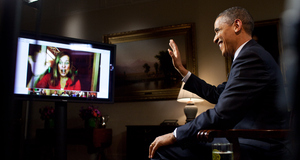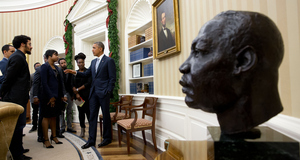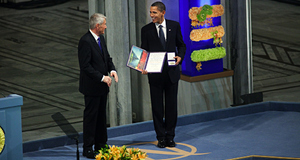The Obama PresidencyDoes "Obamaism" Exist? An Analysis of Ideology and its Place in the Obama Era
By
2015, Vol. 7 No. 02 | pg. 3/3 | « Institutionalized: The Centrist Strain in Domestic PolicyEven with both the House and the Senate, Obama was not certain to get what he wanted. The Democrat party was diverse and particularly divided by regional concerns. Obama’s call for energy reform could be resisted by Democrats from coal-producing states. Health care reform was slowed by divisions in health care costs between the Midwestern and coastal states.52 Which of course is to say nothing of a Republican party that from the start rallied to block any Democrat initiative of reform, refusing to allow Obama to reap any credit for accomplishments in legislature. Obama may be president of the United States, but lawmaking was a matter that was in the hands of the very Washington “cynics” he had criticized in his 2008 campaign. Nancy Pelosi, though supportive of Obama, made it clear she was not at his command; the Democrat Congressmen had, after all, also won their elections. “Yes we wrote this bill, yes we won this election,” as Pelosi put it.53 Despite all this, Obama in his years as president did actually succeed to pass key initiatives that he believed vital for the country. Here I will look at two defining reforms that are representative of Obama’s approach to domestic policy. Both were passed in his first two years of office, when he had the majorities in Congress required to pass significant bills. These perhaps best represent Obamaism translated into institutional domestic programs. They are the education reforms and the Affordable Care Act. On education, the Democrat Congress did expand and create new government programs through which Obamaist currents could flow. Consistent with his belief that stronger education would lead to greater returns in American innovation, Obama oversaw the expansion of Pell grants and replaced the shady bank-based system of student loans with more direct government loans.54 Despite these actions, Obama rarely spoke about them and only one in four Americans could claim to have heard of them.55 Much more touted was the channeling of $4.35 billion in stimulus funds to the Race to the Top program and the Common Core reform for K-12.These were designed to change Bush’s No Child Left Behind Policy. Where No Child Left Behind held funding to schools hostage if they did not meet standardized testing requirements, Race to the Top rewarded with large sums schools that did very well and pumped money into schools that were perceived to be lagging.56 Obama took Bush’s system that treated public schools like a social Darwinian survival of the fittest contest and transformed it so that not only were the rewards more appealing but also so good teachers and a reasonable core were available everywhere— the contest was more “fair.” This fairness of opportunity would gain a greater voice in 2012, when the themes of economic inequality and unequal opportunity were key issues for progressives. Obama also espoused a strong attachment to the idea that innovation could be encouraged by helping schools refocus on math and science. The overwhelming demand was directed at more scientists, more engineers.57 “Think about the America within our reach: A country that leads the world in educating people,” Obama said in his 2012 State of the Union address. “An America that attracts a new generation of high-tech manufacturing and high-paying jobs.”58 “Technology” and “high-tech” are often spoken closely to the word “education” in Obama’s speeches. The new Core program for K-12 was in fact implemented directly in parallel to Obama’s initiative to train 100,000 new teachers in mathematics, science, technology, and engineering (“STEM subjects”).59 What this suggests is that Obama’s contribution to education has been to keep the principles of the game intact but to tweak the rules in such away that students and schools start on a more equal footing. The loan companies still enjoy great clout even without the bank as middleman. Universities have not had to address their increasing tuition fees. Standardized testing remains the primary method by which schools are judged as successful or otherwise. Obamaism contributed small changes to the existing structure to make it more benign and up to date on the scientific and mathematical needs of the US vis-à-vis its international competitors. The Affordable Care Act is the largest and most controversial reform of Obama’s domestic policy. But not only was passing it in the Democrat-controlled Congress much harder than predicted, the communication on the bill to the public was botched. No one was hired to spokesperson for the bill.60 Despite calls by congressman Steve Kagen of Wisconsin to more publicly tout the importance of the ACA and the need to show pride in it, the health care communicator of the White House Stephanie Cutter was content to let the website do the informing. This of course was hardly enough and in 2010 fifty-four Democrats lost their seats in the House, including Kagen.61 A comprehensive health care reform had been a Democrat cause that had been sought after for decades before Obama.62 The primary obstacle had always been the politically entrenched sub-structure that linked the private insurance companies to the government. It was necessary to negotiate and compromise. The most problematic aspect of the bill was the “individual mandate,” the requirement that most persons obtain health insurance by 2014 or pay a tax penalty. This was challenged several times within the judiciary branch, though it has stood so far.63 The aspect of the bill that was struck out was what was known as the “public option,” something the Democrats had run on in 2008 and for which public and medical professional opinion seemed favorable. The public option essentially was a government insurance plan that could be subscribed to as an alternative to the private company insurance plans.64 The hope was this option would help drive down insurance plan prices overall and give a cheaper option to American citizens who could not afford private plans. To get the ACA past the Senate however, the Democrats decided it was not a major part of the bill and could be sacrificed to bring in the vote of an important centrist Democrat holdout. Obama seemed comfortable with this— the cross-ideological consensus that was reached was just as important to him as the contents of the bill itself. Obama was willing to overhaul the problematic health care system, but he did so in a way that in the end suited the private insurance companies just fine.65 There was not the major challenge to their power that Obama seemed to threaten in his campaign. Instead the individual mandate would bring these companies millions of new customers if only they agreed to play by Obama’s “fairer” rules (children could be on their parents plan till the age of 26, inability to deny coverage for pre-existing conditions, set consistent standards for medical plans). In the cases of both education and health, Obama kept the existing systems but tweaked the rules to be more inclusive and opportune to lower income brackets. Freedom of opportunity formed the basis of these changes. The American Dream as Obama sees it relies on everyone having comparable starting points before entering the fruitful competitive market. What these policies also have in common is Obama’s willingness, even desire, to compromise either with conservatives or the private companies so entrenched in their links to the government. He believes strongly in the legitimacy that comes when several differing opinions agree on the value of the idea. In light of this, Obama hardly qualifies as either a raging socialist or weak moderate but someone that had been a firm centrist from the get-go. Obama never really doubted capitalism— his government initiatives were usually to repair or buttress it (as seen with the bailouts to the banks and General Motors). His mantra of freedom of opportunity, his support for healthy competition in the market, and his high ideals of democratic bipartisanship could just as easily have come from a center-right Republican. Flickering: The Tenuous Existence of ObamaismOverall his success in instilling Obamaism into state apparatuses were limited. The successes came through mainly in foreign policy: he presided over a diplomatically active but militarily restrained Unites States that always laid out all options on the table before making radical decisions. Pushing democracy was a common theme in his speeches but he was careful not to make that an actual issue with the powers he dealt with. Obama sought consensus when he moved to do something big on an international scale. The mantra that America must always lead or that America had a duty to go in, allies or no, would be left behind to the Clinton and Bush era. The paradox is that these new policies were comfortably carried out while maintaining the structures left behind by the Bush administration. With domestic policy Obama was able through important programs like Race to the Top and the ACA to create completely new government domains that carried out his and other Obamaists’ visions for America. That vision tended to be politically centrist and economically liberal capitalist— they were not revolutionary but instead served to incentivize and motivate the existing private organizations to work for the government check.66 While he can be satisfied of the existence of these programs he will have to be constantly weary of how few Americans tend to be aware of them. He was never able to properly communicate what the benefits or accomplishments of these new institutions were and this left the door open for the broad misinterpretations his political enemies thrived off of— he underestimated how much Americans were being fed conservative narratives: how tax cuts were the only way to spur jobs, how spending hurts the economy.67 Observers like Theda Skocpol believed this lack of high profile leadership constituted “political malpractice” on his part.68 Suzanne Mettler in a response to Skocpol writes that it is just as much the nature of what Obama tried to change as his communication that rendered his reforms invisible. What she calls the “submerged state” is a huge body of government connections to private bodies and individuals doing public service on behalf of the government.69 Ordinary citizens do not interact with the government directly when using these services. Education is a good example of this: students would still interact with new government benefits as if they were still dealing with the previous bank-based system.70 This makes it very difficult for Obama’s administration to claim credit. His legacy and vision may yet endure in these programs, but in the near future it is unlikely that Obamaism will be recognized if expounded by a different Democrat. As a real ideology, as one that feeds off of a memorable performance, of implemented systems and broad principles, Obamaism shows signs that only a few of its aspects will endure. This is primarily the decision of Barack Obama himself; he has little patience for the constant communication campaign required for that sort of thing. The second reason is the American system itself. It has evolved in such a way that it is impossible for the government to maintain or completely control any kind of narrative. Important legacies of previous presidents do survive— the civil rights act, social security, the CIA. If the Republicans are foiled until the end of his mandate and then fail to win in 2016, Obama will likely have the ACA as his permanent legacy of ideological contribution to the country. But so many of the changes Obama enacted are so easily subsumed by the sheer complexity of the current government system— tax reform, ecological measures, student loan reform, and much more. American citizens will not think of him if they are at all aware that they benefit from these accomplishments. So why so much passion and excitement over his name? Here we are still very much feeling the consequences of the 2008 campaign. When a symbol is built and then is left unattended in the aftermath, the people can take these images and these feelings in all sorts of directions. Disillusionment. Admiration. Disappointment. Expectation. The media, the political enemies, the outside observers all create their own caricatures of Obama through their small prisms. And 2008 presented such grand ideological possibility that the crater it left behind provided fodder not just for the disappointment by his supporters but also for the proportionate rightwing backlash that followed quickly behind. It is all too common of a phenomenon that where there is strong potential for the sort of sweeping reforms people like Skocpol, like the TIME magazine writers, like Kuttner were waiting for, and the left fails to mobilize this potential, then this emotional disaffection inevitably becomes coopted by the right.71 It is this failed ideological potential that allows 2008 to be a lightning rod of disappointment and vitriol from all sides, no matter how far from reality the media’s expectations for Obama may be. “I say what they say I say. I become who they say I’ve become,” Obama muses in a now oddly prophetic passage in The Audacity of Hope.72 Obama should have understood that when he was undertaking the rhetoric and symbolism of a great uniter that a construct so large and broad falls all the harder if he does not actively fight to preempt disappointment or misunderstanding of his goals. Every step after taking the presidency seemed to cement this loss of narrative. Constant narrative control may not be what Obama wanted or how he envisioned leadership. It was however, unrealistic for him to believe he could undertake projects like the ACA around which the media were aflame and not even consider a stronger communication strategy. The caricatures this absence allows misdirects our vision away from the actual Obama and his actual ideology in effect rendering his ideology nonexistent to us while we invent our own perception of what it is. ReferencesAlexander, Jeffrey C. The Performance of Politics: Obama’s Victory and the Democratic Struggle for Power. (Oxford University Press; 2010) Alter, Jonathan. The Center Holds: Obama and his Enemies. (Simon & Schuster; 2013). Althusser, Louis. “Ideology and Ideological State Apparatuses.” Essays on Ideology. (Verso; 1994). Bailey, Holly. Politics: Barack Obama’s Pelosi Problem. Newsweek. Feb. 27th 2009. http://www.newsweek.com/politics-barack-obamas-nancy-pelosi-problem-82381. Balz, Dan & Haynes Johnson. The Battle for America 2008: The Story of an Extraordinary Election. (Viking Penguin; 2009). Barthes, Roland. “The Rhetoric of the Image” Image, Music, Text. (New York: Hill and Wang; 1977). Beinart, Peter. The New Liberal Order. TIME. Nov. 24th 2008. Bernstein, Carl. A Woman in Charge: The Life of Hillary Rodham Clinton. (New York: Vintage; 2007) Boerma, Lindsey. Obama Reflects on his Biggest Mistake as President. CBS. July 12th 2012. http://www.cbsnews.com/news/obama-reflects-on-his-biggest-mistake-as-president/. Brennan, John. “A New Approach for Safeguarding Americans.” Speech to Center for Strategic and International Studies. Aug. 26th 2009. Brzezinski, Zbigniew. America in a Hostile World. Foreign Policy. Summer 1976. Cohn, Jonathan. How They Did It. The New Republic. May 21st 2010. http://www.newrepublic.com/article/75077/how-they-did-it. Full Text: Obama’s Victory Speech. BBC. Nov. 5th 2008. http://news.bbc.co.uk/2/hi/americas/us_elections_2008/7710038.stm. Griff Witte, Mary Beth Sheridan, & Karen DeYoung. Rifts Stall Egypt Talks. Washington Post. Feb. 6th 2011. Judis, John B. The Unecessary Fall. The New Republic. Aug. 12th 2010. http://www.newrepublic.com/article/politics/magazine/76972/obama-failure-polls-populism-recession-health-care. Kuttner, Robert. Obama’s Challenge: America’s Economic Crisis and the Power of A Transformative Presidency. (Chelsea Green Publishing; 2008). Mann, James. The Obamians: The Struggle Inside the White House to Redefine American Power. (Viking Penguin; 2012). McGregor, Richard. The Party: The Secret World of China’s Communist Rulers. (HarperCollins Publishers; 2010). Mettler, Suzanne. “Obama and the Challenge of Submerged Policies.” Alexis de Toqueville Lectures on American Politics. (Harvard; 2012). Mettler, Suzanne. “Reconstituting the Submerged State: The Challenges of Social Policy Reform in the Obama Era.” Perspectives on Politics 8 No.3 (2010). Miller, Tiffany & Robert Hana. Four Years Later, Are Race to the Top States on Track? Center for American Progress. March 24th 2014. Miroff, Bruce. The Liberal’s Moment: The McGovern Insurgency and the Identity Crisis of the Democratic Party. (Lawrence: University Press of Kansas; 2009). Obama, Barack. The Audacity of Hope: Thoughts on Reclaiming the American Dream. (Crown Publishers; 2006). Remarks by the President in the State of the Union Address. The White House. Office of the Press Secretary. Jan.24th 2012. http://www.whitehouse.gov/the-press-office/2012/01/24/remarks-president-state-union-address. Rennick, David. The Bridge: The Life and Rise of Barack Obama. (Vintage; 2011) pg. 179. Skocpol, Theda. “Obama’s New Deal, Tea Party Reaction, and America’s Political Future.” Alexis de Toqueville Lectures on American Politics. (Harvard; 2012) Text: Obama’s Speech in Cairo. New York Times. June 4th 2009. http://www.nytimes.com/2009/06/04/us/politics/04obama.text.html?pagewanted=all. Transcript: Illinois Senate Candidate Barack Obama. The Washington Post. July 27th 2004. http://www.washingtonpost.com/wp-dyn/articles/A19751-2004Jul27.html. U.S. National Security Strategy, May 2010. Zizek, Slavoj. First as Tragedy, Then as Farce. (Verso; 2009) Zizek, Slavoj. The Sublime Object of Ideology. (Verso; 1989) Endnotes1.) Althusser, Louis. “Ideology and Ideological State Apparatuses.” Essays on Ideology. (Verso; 1994). Pg 36-40 2.) Zizek, Slavoj. The Sublime Object of Ideology. (Verso; 1989) pg. 12 3.) Zizek, Slavoj. Pg 26 4.) Althusser, Louis. Pg. 39 5.) Althusser, Louis. Pg. 41 6.) Alexander, Jeffrey C. The Performance of Politics: Obama’s Victory and the Democratic Struggle for Power. (Oxford University Press; 2010) Pg. 13 7.) Transcript: Illinois Senate Candidate Barack Obama. The Washington Post. July 27th 2004. http://www.washingtonpost.com/wp-dyn/articles/A19751-2004Jul27.html 8.) Obama, Barack. The Audacity of Hope: Thoughts on Reclaiming the American Dream. (Crown Publishers; 2006). Pg. 22 9.) Obama, Barack. Pg. 39 10.) Obama, Barack. Pg. 308 11.) Rennick, David. The Bridge: The Life and Rise of Barack Obama. (Vintage; 2011) pg. 179 12.) Barthes, Roland. “The Rhetoric of the Image” Image, Music, Text. (New York: Hill and Wang; 1977) Pg. 32-51 13.) Alexander, Jeffrey C. Pg. 48-49 14.) Balz, Dan & Haynes Johnson. The Battle for America 2008: The Story of an Extraordinary Election. (Viking Penguin; 2009) Pg. 106 15.) Ibid. 16.) Full Text: Obama’s Victory Speech. BBC. Nov. 5th 2008. http://news.bbc.co.uk/2/hi/americas/us_elections_2008/7710038.stm 17.) Balz & Johnson. Pg. 371 18.) Ibid. 19.) Alter, Jonathan. The Center Holds: Obama and his Enemies. (Simon & Schuster; 2013) Pg. 92 20.) Ibid. 21.) Beinart, Peter. The New Liberal Order. TIME. Nov. 24th 2008. Pg. 30 22.) Judis, John B. The Unecessary Fall. The New Republic. Aug. 12th 2010. http://www.newrepublic.com/article/politics/magazine/76972/obama-failure-polls-populism-recession-health-care 23.) Kuttner, Robert. Obama’s Challenge: America’s Economic Crisis and the Power of A Transformative Presidency. (Chelsea Green Publishing; 2008). Pg. 1 24.) Skocpol, Theda. “Obama’s New Deal, Tea Party Reaction, and America’s Political Future.” Alexis de Toqueville Lectures on American Politics. (Harvard; 2012). Pg. 8 25.) Alter, Jonathan. Pg. 92 26.) Ibid. 27.) Alter, Jonathan. Pg. 118 28.) Boerma, Lindsey. Obama Reflects on his Biggest Mistake as President. CBS. July 12th 2012. http://www.cbsnews.com/news/obama-reflects-on-his-biggest-mistake-as-president/ 29.) Alter, Jonathan. Pg. 118 30.) Alter, Jonathan Pg. 122 31.) Mann, James. The Obamians: The Struggle Inside the White House to Redefine American Power. (Viking Penguin; 2012) Pg. 212 32.) Alter, Jonathan Pg. 322 33.) Alter, Jonathan Pg. 313 34.) Althusser, Louis. 23 35.) Balz & Johnson. Pg. 22 36.) Mann, James. 71-72 37.) Miroff, Bruce. The Liberal’s Moment: The McGovern Insurgency and the Identity Crisis of the Democratic Party. (Lawrence: University Press of Kansas; 2009) pg. 128 38.) Bernstein, Carl. A Woman in Charge: The Life of Hillary Rodham Clinton. (New York: Vintage; 2007) pg. 85 39.) Mann, James. 16-17 40.) Brzezinski, Zbigniew. America in a Hostile World. Foreign Policy. Summer 1976. Pg 90-92 41.) Mann, James. Pg. 33-34 42.) Ibid. 43.) Balz & Johnson. Pg. 166 44.) Mann, James. Pg. 87 45.) Brennan, John. “A New Approach for Safeguarding Americans.” Speech to Center for Strategic and International Studies. Aug. 26th 2009 46.) Mann, James, Pg. 116 47.) Mann, James, Pg 167-170 48.) Griff Witte, Mary Beth Sheridan, & Karen DeYoung. Rifts Stall Egypt Talks. Washington Post. Feb. 6th 2011. Pg. A-1 49.) Text: Obama’s Speech in Cairo. New York Times. June 4th 2009. http://www.nytimes.com/2009/06/04/us/politics/04obama.text.html?pagewanted=all 50.) McGregor, Richard. The Party: The Secret World of China’s Communist Rulers. (HarperCollins Publishers; 2010). Pg. xiv. 51.) U.S. National Security Strategy, May 2010. Pg. 9 52.) Skocpol, Theda. Pg. 12 53.) Bailey, Holly. Politics: Barack Obama’s Pelosi Problem. Newsweek. Feb. 27th 2009. http://www.newsweek.com/politics-barack-obamas-nancy-pelosi-problem-82381 54.) Mettler, Suzanne. “Obama and the Challenge of Submerged Policies.” Alexis de Toqueville Lectures on American Politics. (Harvard; 2012) Pg. 133 55.) Mettler, Suzanne. “Reconstituting the Submerged State: The Challenges of Social Policy Reform in the Obama Era.” Perspectives on Politics 8 No.3 (2010). Pg. 814 56.) Rockman, Rudalevige, Campbell. The Obama Presidency. (CQ Press, 2012) pg. 251 57.) Miller, Tiffany & Robert Hana. Four Years Later, Are Race to the Top States on Track? Center for American Progress. March 24th 2014 58.) Remarks by the President in the State of the Union Address. The White House. Office of the Press Secretary. Jan.24th 2012. http://www.whitehouse.gov/the-press-office/2012/01/24/remarks-president-state-union-address 59.) Ibid. 60.) Alter, Jonathan. Pg. 115-116 61.) Ibid. 62.) Mettler, Suzanne. “Obama and the Challenge of Submerged Policies.” Pg. 136 63.) Cohn, Jonathan. How They Did It. The New Republic. May 21st 2010. http://www.newrepublic.com/article/75077/how-they-did-it 64.) Ibid. 65.) Mettler, Suzanne. Pg. 136 66.) Mettler, Suzanne. Pg. 131 67.) Skocpol, Theda. Pg. 37 68.) Ibid. 69.) Mettler, Suzanne. Pg. 131 70.) Mettler, Suzanne. Pg. 135 71.) Zizek, Slavoj. First as Tragedy, Then as Farce. (Verso; 2009) pg. 73 72.) Obama, Barack. Pg. 121 Suggested Reading from Inquiries Journal
Inquiries Journal provides undergraduate and graduate students around the world a platform for the wide dissemination of academic work over a range of core disciplines. Representing the work of students from hundreds of institutions around the globe, Inquiries Journal's large database of academic articles is completely free. Learn more | Blog | Submit Latest in Political Science |


















